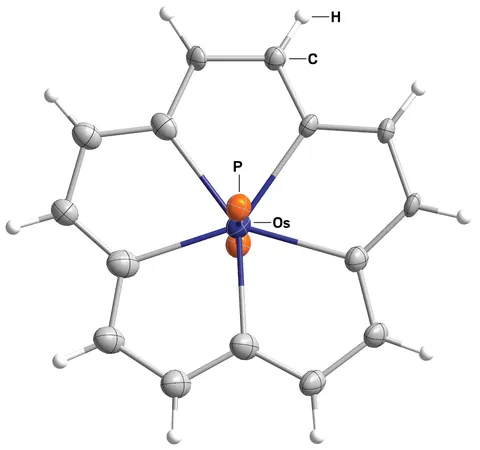
Revolutionary Discovery: Osmium Trapped in Hydrocarbon Framework!
2025-04-30
Author: Arjun
Chemistry Breakthrough: A New Class of Organometallic Compounds!
In an exciting new development, chemists have ingeniously woven an aromatic hydrocarbon framework around an osmium ion, leading to the birth of a groundbreaking class of organometallic compounds known as in-plane metallo-annulenes. These remarkable carbon clusters, infused with transition metals, hold immense potential for high-performance electronics and could pave the way for metal-doped graphene innovations.
What Makes These Metallo-Annulenes Unique?
Unlike traditional organometallic compounds, where metals hover above or below the flat plane of hydrocarbons, these in-plane metallo-annulenes have the metal sitting right within the aromatic hydrocarbon's plane. This unique positioning allows the osmium to actively participate in the molecule’s π conjugation and aromaticity, a feature that brings to mind the structure of porphyrins—flat, nitrogen-rich rings that hold metal ions like iron in heme.
A Decade in the Making: Meet Haiping Xia!
Leading this revolutionary project is Haiping Xia from the Southern University of Science and Technology. With a decade of research behind him, Xia emphasizes that current evidence showcases this stylish metal-centered planar annulene as possessing stronger aromaticity than benzene itself! His team successfully synthesized three versions of these compounds through a meticulous four-step process, beginning with a precursor featuring a reactive osmium-carbon triple bond.
The Chemistry Behind the Magic!
The most symmetrical of these newly created compounds contains a fascinating arrangement of 15 carbon atoms within five fused five-membered rings, all circling an osmium bis(phosphine) core. Additionally, Xia's team has been able to produce chlorinated, iodinated, and nitrated derivatives of this base molecule, with plans to explore variations in size and different metals.
Experts Weigh In: A Game-Changer for Chemistry!
This discovery has garnered significant attention within the scientific community. Marina A. Petrukhina, a researcher at the University at Albany, heralds the creation of these molecules as a groundbreaking step that will introduce new building blocks for both organometallic and materials chemistry. Similarly, Michael M. Haley from the University of Oregon praises the team's ability to achieve clean electrophilic aromatic substitution with high yields, calling it the 'icing on the cake' and suggesting this work will redefine metalla-aromaticity in chemistry textbooks!


 Brasil (PT)
Brasil (PT)
 Canada (EN)
Canada (EN)
 Chile (ES)
Chile (ES)
 Česko (CS)
Česko (CS)
 대한민국 (KO)
대한민국 (KO)
 España (ES)
España (ES)
 France (FR)
France (FR)
 Hong Kong (EN)
Hong Kong (EN)
 Italia (IT)
Italia (IT)
 日本 (JA)
日本 (JA)
 Magyarország (HU)
Magyarország (HU)
 Norge (NO)
Norge (NO)
 Polska (PL)
Polska (PL)
 Schweiz (DE)
Schweiz (DE)
 Singapore (EN)
Singapore (EN)
 Sverige (SV)
Sverige (SV)
 Suomi (FI)
Suomi (FI)
 Türkiye (TR)
Türkiye (TR)
 الإمارات العربية المتحدة (AR)
الإمارات العربية المتحدة (AR)